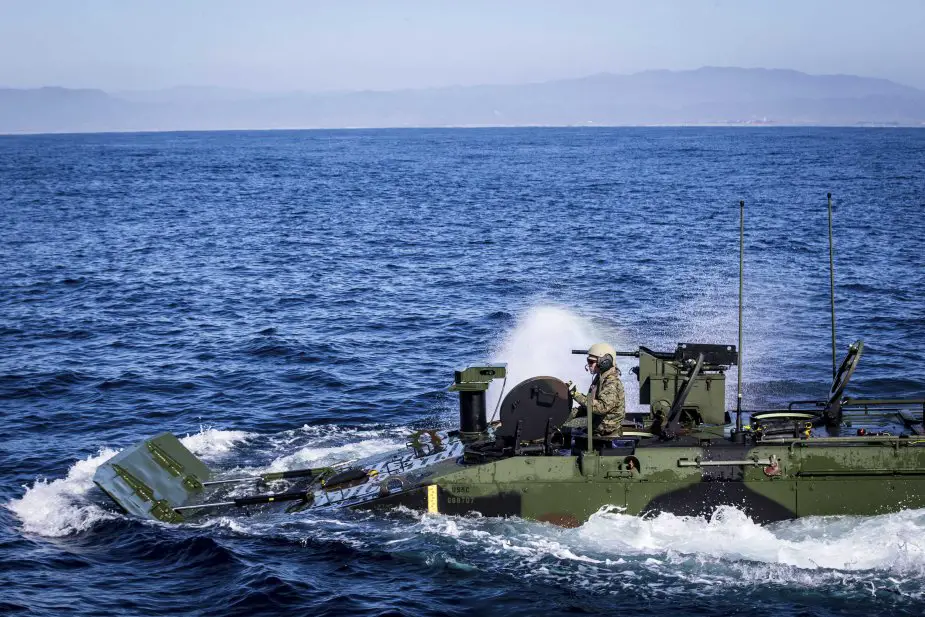Issued on Feb. 20, 2020, a Congressional Research Service report makes the point on the Marine Corps’ Amphibious Combat Vehicle (ACV) background and formulates issues for the U.S. Congress. Its content is summarized hereafter.

Amphibious Combat Vehicle during testing by the U.S.M.C. (Picture source: U.S. Marine Corps)
On January 6, 2011, after spending approximately $3 billion in developmental funding, the Marine Corps canceled the Expeditionary Fighting Vehicle (EFV) program due to poor reliability demonstrated during operational testing and excessive cost growth. Because the EFV was intended to replace the 40-year-old Amphibious Assault Vehicle (AAV) dating back to the Vietnam war era, the Pentagon pledged to move quickly to develop a “more affordable and sustainable” vehicle to replace the EFV.
Hence, the Amphibious Combat Vehicle (ACV) is intended to replace the AAV, incorporating some EFV capabilities but in a more practical and cost-efficient manner. In parallel with the ACV, the Marines were developing the Marine Personnel Carrier (MPC) to serve as a survivable and mobile platform to transport Marines when ashore. The MPC was not intended to be amphibious like an AAV, EFV, or the ACV but instead would be required to have a swim capability for inland waterways such as rivers, lakes, and other water obstacles such as shore-to-shore operations in the littorals. Both vehicles were intended to play central roles in future Marine amphibious operations. On June 14, 2013, Marine leadership froze the MPC program because of budgetary pressures but suggested the program might be resurrected some ten years later when budgetary resources might be higher.
Earlier than expected, the Marines decided to reactivate the MPC in March 2014. They designated the MPC as “ACV Increment 1.1” and planned to acquire about 200 vehicles. The Marines also planned to develop “ACV Increment 1.2”, a tracked, fully amphibious version, and at the time planned to acquire about 470 vehicles and fund an ongoing high water speed study. Although ACV Increment 1.1 is to have a swim capability, another mode of transport (ship or aircraft) would be required to get the vehicles from ship to shore. The Marines are reportedly exploring the possibility of developing a high water speed “ACV 2.0”, which could accompany tanks and light armored vehicles into combat.
On November 5, 2014, the Marines released a draft Request for Proposal (RFP) for “ACV Increment 1.1”. On November 24, 2015, the Marine Corps awarded BAE Systems and SAIC contracts to develop ACV 1.1 prototypes for evaluation. BAE’s contract was for $103.8 million and SAIC’s for $121.5 million, and each company was to build 16 prototypes to be tested over the next two years. Both BAE and SAIC delivered their prototypes early, and Engineering and Manufacturing Development (EMD) testing began mid-March 2017. In early December 2017, the Marines reportedly sent the ACV 1.1 down select request for proposals to BAE and Science Applications International Corporation (SAIC).
On June 19, 2018, the Marine Corps selected BAE Systems to produce the ACV. The initial contract—valued at $198 million—was for low-rate production of 30 vehicles to be delivered by the autumn of 2019. On April 10, 2019, during testimony to the Senate Armed Services Committee, Navy and Marine Corps leadership announced that during the fall of 2018, ACV 1.1 prototypes demonstrated satisfactory water mobility performance in high surf conditions and, in doing so, met the full water mobility transition requirement for ACV 1.2 capability. As a result, ACV 1.1 and ACV 1.2 were to be consolidated into a single variant—the ACV—which is intended to replace all AAVs.
Potential issues for Congress include the potential ramifications of the consolidation of the ACV 1.1 and ACV 1.2 programs and how the possible adoption of the Expeditionary Advance Base Operations (EABO) operational concept could affect the ACV program.















